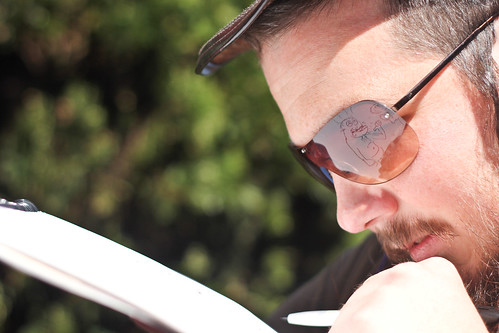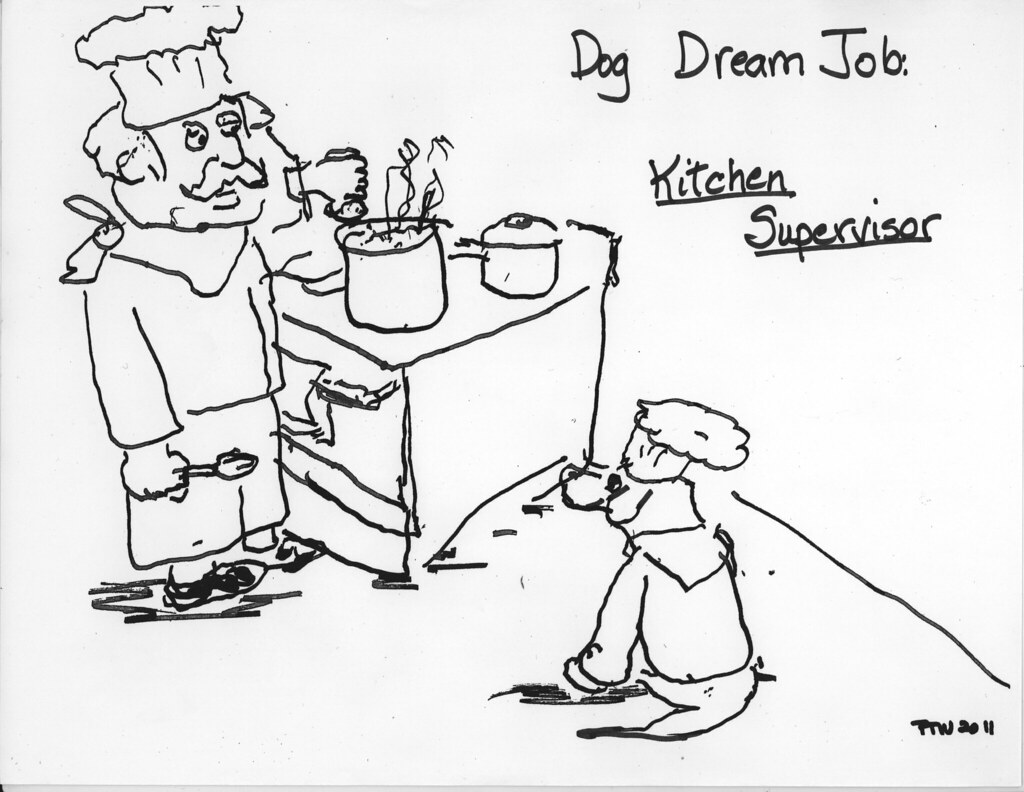
Patrick Ward makes himself comfortable on a bench in Cafe Rosso’s popular patio area, hunched merely 6 inches away from his sketchpad and intent on drawing his next cartoon masterpiece to add to his portfolio. He is visually impaired, making this no small feat.
Ward, 28, student and cartoonist, faces unique challenges in both the publishing industry and the campus community.
The graduate student has pitched his drawings to The New York Times, Union Democrat and Mad Magazine, but like many others who submit creative work in hopes of being published, Ward has become accustomed to the sting of rejection.
“I haven’t been published yet,” Ward said. “With Mad Magazine, the first couple times I sent them something, they’ve always said, ‘We don’t have room for this right now.’ When they rejected me, they were very nice about it.”
He once wrote a letter to the editor of Access Magazine, a national publication that has since discontinued, describing his style of drawing and expressing his desire to be hired as a cartoonist. When he received a call back from that publication, the editor told him the pictures look like they were drawn by a disabled person. Comments like these indicate that while the editor may have seen his photos, they did not read the letter.
Ward has a genetic retinal disorder called rod/cone dystrophy. His eyes lack a sufficient number of rods and cones in his retina, which are responsible for color and depth, and the ones he has are slowly decaying. The disorder leaves him with a vision of approximately 20/1000 vision in both eyes. This means, for example, that Ward would need to be about 6 inches away from the whiteboard in class in order to read what a professor wrote, while a student with 20/20 vision would be able to read the same print from the back row.
He recalls seeing the signs of his declining vision when he was younger.
“When I was a kid, my drawings looked a little odd because I had trouble when someone unwrapped the crayons, removing the name of the crayon and making it harder for me to tell between a red, purple, green and blue,” Ward said. “Some colors are harder for me to see than others.”
According to Anne Ward, Patrick’s mother, the family didn’t notice he had a visual problem until he was about 3 years old. His eyes would move rapidly back and forth in an unconscious effort to improve his vision, which is part of a condition called nystagmus. This was accompanied by head shaking, another effort to see better.
“The eye oscillation and head shaking have mostly disappeared, even though his vision had worsened over the years,” she said.
His vision plateaued when he turned 18 years old and it created more obstacles for him to face. His vision worsened, making it harder for him to do his school work.
Even as a student at the University, Ward has distinct needs that could hinder him from academic success if they aren’t met.
“I have to have my books converted into a format that I can read. Sometimes I have to wait a long time,” he said. “If a teacher doesn’t post a book before the start of the semester, that might mean I might not have the book in a form that I can read until about a third of the way through or more. Quite often, I have to play a lot of catch-up.”
Ward admits the difficulty in seeking out assistance from others in a fast-paced city like San Francisco.
“The hardest thing for me, because I’m not somebody who likes to go up and bother people, is asking for help, assistance or direction when I’m out in public or when I get lost,” he said. “Especially in San Francisco, where everyone else can look up and see the street sign, I have to find somebody who’s willing to answer my question.”
Ward has had to deal with instances of others attempting to take advantage of him in public spaces.
“When I was out purchasing things, a clerk at a liquor store (tried) to overcharge me for something, and I knew they were because I had bought the same thing in the store like a month before,” said Ward. “I had to go and get a manager involved.”
One of Ward’s closest on-campus companions is his guide dog Clay, with whom he can be seen when he sits outside near Burk Hall or Cafe Rosso drawing away on his sketch pad, coffee in hand. The golden retriever has been with Ward for the past four years and has become a trustworthy friend in direction and assistance.
Ward adds that Clay is a social advantage, attracting random people to come over and play with him. In this way, he becomes a conversation starter for Ward.
“Before I had him, no one really paid attention to me,” Ward said. “Clay provides hours of entertainment and love which makes my life a bit more enjoyable.”
Editorial cartoons are Ward’s expertise. He believes that there is a lot to poke fun at and could actually get people to think through his drawings, and usually watches the news or The Daily Show for inspiration.
Ward has worked around his impairment and developed a special technique to sketch.
“I have enough vision to lift my pen and move to other spots on the paper once I’ve started drawing. I just have it 5 or 6 inches away from my face,” he said.
Long-standing family friend Judith Lesner-Buxton, 69, supports his drawings and future plans as a cartoonist.
“I know Patrick will be a successful cartoonist. He’s funny and he’s been drawing since he was a kid,” said Lesner. “I support whatever he wants to become and I know he will be good.”
Lesner bought one of Ward’s clay sculptures during art exhibit in Ukiah, Calif., where they feature a local artist every four to six weeks at a yoga studio.
“He had all of his artwork and clay sculptures everywhere and I can tell he was excited. I purchased a clay sculpture of a dragon, but I’m not sure if he sold a lot of paintings. But I do know that he made the Ukiah Daily Journal newspaper,” added Lesner.
Even though Ward made the Ukiah paper, not everyone knows about his artwork.
Ali Borjian, an associate professor of secondary education at SF State, was Ward’s professor in literacy instruction, which focuses on preparing teacher candidates for teaching reading to diverse students.
“I met Patrick at the beginning of the semester and quite honestly, I haven’t done enough to get to know him,” Borjian said.
Anne believes that people with deficiencies should not be stifled from having healthy social lives.
“All too often, other people seem to think that having a disability means that the person with the disability is less than human. I think that disabilities are intimidating to other folks, to the point where they just avoid the topic,” she said.
Matt Ward, one of Patrick’s brothers, said he’s unique because of his distinctive sense of humor, imagination and wittiness.
“He is an inspiration to anyone who is disabled, showing that your physical impairments don’t need to get in the way of your dreams. He is an amazing, talented artist,” he said.

Patrick prefers to keep to himself, finding company through his dog and his sketchpad.






